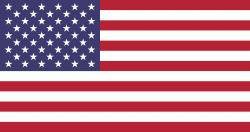Jarvis Island (Jarvis Island)
Jarvis Island (formerly known as Bunker Island or Bunker's Shoal) is an uninhabited 4.5 km2 coral island located in the South Pacific Ocean, about halfway between Hawaii and the Cook Islands. It is an unincorporated, unorganized territory of the United States, administered by the United States Fish and Wildlife Service of the United States Department of the Interior as part of the National Wildlife Refuge system. Unlike most coral atolls, the lagoon on Jarvis is wholly dry.
Jarvis is one of the Line Islands and for statistical purposes is also grouped as one of the United States Minor Outlying Islands. Jarvis Island is the largest of three U.S. equatorial possessions, which include Baker Island and Howland Island.
While a few offshore anchorage spots are marked on maps, Jarvis island has no ports or harbors, and swift currents are a hazard. There is a boat landing area in the middle of the western shoreline near a crumbling day beacon, and another near the southwest corner of the island. The center of Jarvis island is a dried lagoon where deep guano deposits accumulated, which were mined for about 20 years during the nineteenth century. The island has a tropical desert climate, with high daytime temperatures, constant wind, and strong sun. Nights, however, are quite cool. The ground is mostly sandy and reaches 23 ft at its highest point. The low-lying coral island has long been noted as hard to sight from small ships and is surrounded by a narrow fringing reef.
Jarvis Island is one of two United States territories that are in the southern hemisphere (the other is American Samoa). Located only 25 mi south of the equator, Jarvis has no known natural freshwater lens and scant rainfall. This creates a very bleak, flat landscape without any plants larger than shrubs. There is no evidence that the island has ever supported a self-sustaining human population. Its sparse bunch grass, prostrate vines and low-growing shrubs are primarily a nesting, roosting, and foraging habitat for seabirds, shorebirds, and marine wildlife.
Jarvis Island was submerged underwater during the latest interglacial period, roughly 125,000 years ago, when sea levels were 5 – higher than today. As the sea level declined, the horseshoe-shaped lagoon was formed in the center of Jarvis Island.
Jarvis is one of the Line Islands and for statistical purposes is also grouped as one of the United States Minor Outlying Islands. Jarvis Island is the largest of three U.S. equatorial possessions, which include Baker Island and Howland Island.
While a few offshore anchorage spots are marked on maps, Jarvis island has no ports or harbors, and swift currents are a hazard. There is a boat landing area in the middle of the western shoreline near a crumbling day beacon, and another near the southwest corner of the island. The center of Jarvis island is a dried lagoon where deep guano deposits accumulated, which were mined for about 20 years during the nineteenth century. The island has a tropical desert climate, with high daytime temperatures, constant wind, and strong sun. Nights, however, are quite cool. The ground is mostly sandy and reaches 23 ft at its highest point. The low-lying coral island has long been noted as hard to sight from small ships and is surrounded by a narrow fringing reef.
Jarvis Island is one of two United States territories that are in the southern hemisphere (the other is American Samoa). Located only 25 mi south of the equator, Jarvis has no known natural freshwater lens and scant rainfall. This creates a very bleak, flat landscape without any plants larger than shrubs. There is no evidence that the island has ever supported a self-sustaining human population. Its sparse bunch grass, prostrate vines and low-growing shrubs are primarily a nesting, roosting, and foraging habitat for seabirds, shorebirds, and marine wildlife.
Jarvis Island was submerged underwater during the latest interglacial period, roughly 125,000 years ago, when sea levels were 5 – higher than today. As the sea level declined, the horseshoe-shaped lagoon was formed in the center of Jarvis Island.
Map - Jarvis Island (Jarvis Island)
Map
Country - United_States_Minor_Outlying_Islands
 |
 |
In 1936, a colonization program began to settle Americans on Baker, Howland, and Jarvis, but all three islands were evacuated in 1942 as a result of World War II.
Currency / Language
| ISO | Currency | Symbol | Significant figures |
|---|---|---|---|
| USD | United States dollar | $ | 2 |
| ISO | Language |
|---|---|
| EN | English language |















